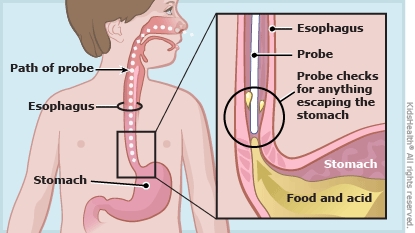An impedance (im-PEE-dints) probe test helps your health care provider find out if stomach acid is leaving the stomach and moving up toward the throat — a condition called gastroesophageal reflux (GER) or reflux.
The health care provider slid the probe (a thin tube with sensors) through your child's nose and into the esophagus (the passageway that takes food from the throat to the stomach). Some of the sensors track if anything comes back out of the stomach into the esophagus and how often that happens. Other sensors track the acid level (pH) of the stomach liquid. The probe is usually kept in place for 24 hours to take measurements while your child does normal activities like eat, drink, and sleep.



Your child:

Your child:

When will we get the results of the impedance probe test? The results are usually available in 1–2 weeks. Your health care provider will carefully review the report and discuss the findings with you.